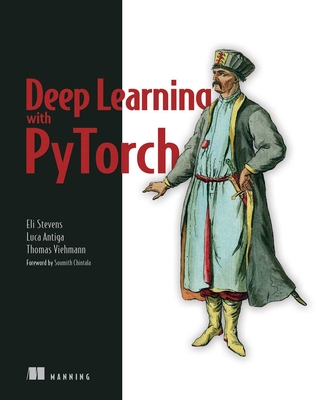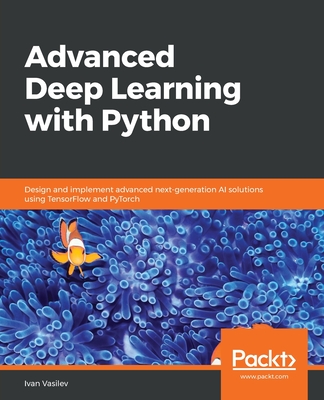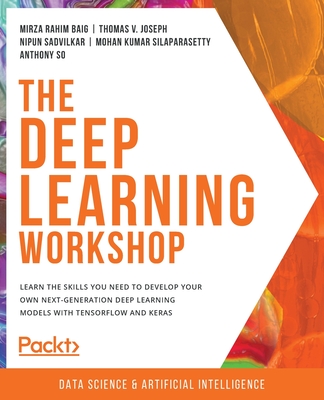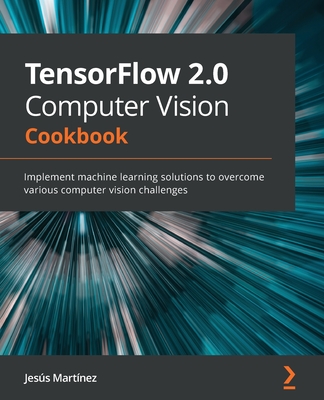Deep Learning for Beginners
A beginner's guide to getting up and running with deep learning from scratch using Python
暫譯: 初學者的深度學習
Pablo Rivas
- 出版商: Packt Publishing
- 出版日期: 2020-09-18
- 定價: $1,350
- 售價: 9.5 折 $1,283
- 語言: 英文
- 頁數: 341
- 裝訂: Paperback
- ISBN: 1838640851
- ISBN-13: 9781838640859
-
相關分類:
DeepLearning
-
相關翻譯:
深度學習初學者指南 (簡中版)
立即出貨 (庫存=1)
買這商品的人也買了...
-
 $1,617Deep Learning (Hardcover)
$1,617Deep Learning (Hardcover) -
 $505Processing 編程學習指南(原書第2版)
$505Processing 編程學習指南(原書第2版) -
 TensorFlow + Keras 深度學習人工智慧實務應用
TensorFlow + Keras 深度學習人工智慧實務應用$590$460 -
 $2,081Python for Programmers: with Big Data and Artificial Intelligence Case Studies (Paperback)
$2,081Python for Programmers: with Big Data and Artificial Intelligence Case Studies (Paperback) -
 Python 機器學習與深度學習特訓班:看得懂也會做的 AI人工智慧實戰 (附120分鐘影音教學/範例程式)
Python 機器學習與深度學習特訓班:看得懂也會做的 AI人工智慧實戰 (附120分鐘影音教學/範例程式)$520$411 -
 TensorFlow 與 Keras - Python 深度學習應用實務
TensorFlow 與 Keras - Python 深度學習應用實務$650$553 -
 3天搞懂技術分析:看懂走勢、解讀線圖,橫掃股市乘風破浪!
3天搞懂技術分析:看懂走勢、解讀線圖,橫掃股市乘風破浪!$320$272 -
 深度學習 (Deep Learning)(繁體中文版)
深度學習 (Deep Learning)(繁體中文版)$1,200$1,020 -
 Deep Learning with Pytorch (Paperback)
Deep Learning with Pytorch (Paperback)$1,990$1,891 -
 $1,425Advanced Deep Learning with TensorFlow 2 and Keras - Second Edition
$1,425Advanced Deep Learning with TensorFlow 2 and Keras - Second Edition -
 88張圖看懂 技術分析:你也能跟他一樣,10年賺到7000萬!
88張圖看懂 技術分析:你也能跟他一樣,10年賺到7000萬!$300$255 -
 Practical Deep Learning: A Python-Based Introduction
Practical Deep Learning: A Python-Based Introduction$2,052$1,944 -
 Developing Graphics Frameworks with Python and OpenGL (Hardcove)
Developing Graphics Frameworks with Python and OpenGL (Hardcove)$4,200$3,990 -
 $2,682Practical Machine Learning for Computer Vision: End-To-End Machine Learning for Images (Paperback)
$2,682Practical Machine Learning for Computer Vision: End-To-End Machine Learning for Images (Paperback) -
 Deep Learning Patterns and Practices (Paperback)
Deep Learning Patterns and Practices (Paperback)$1,995$1,890 -
 Optimizing Visual Studio Code for Python Development: Developing More Efficient and Effective Programs in Python
Optimizing Visual Studio Code for Python Development: Developing More Efficient and Effective Programs in Python$2,350$2,233 -
 $1,501Code That Fits in Your Head: Heuristics for Software Engineering
$1,501Code That Fits in Your Head: Heuristics for Software Engineering -
 Keras 大神歸位:深度學習全面進化!用 Python 實作 CNN、RNN、GRU、LSTM、GAN、VAE、Transformer
Keras 大神歸位:深度學習全面進化!用 Python 實作 CNN、RNN、GRU、LSTM、GAN、VAE、Transformer$1,200$948 -
 $1,853Learn Three.js : Program 3D animations and visualizations for the web with JavaScript and WebGL, 4/e (Paperback)
$1,853Learn Three.js : Program 3D animations and visualizations for the web with JavaScript and WebGL, 4/e (Paperback) -
 Python + ChatGPT 零基礎 + 高效率學程式設計與運算思維, 3/e
Python + ChatGPT 零基礎 + 高效率學程式設計與運算思維, 3/e$780$616 -
 ChatGPT × 遊戲設計概論
ChatGPT × 遊戲設計概論$720$540 -
 ChatGPT-4 與 Bing Chat - 創新體驗文字/繪圖/音樂/動畫/影片的AI世界
ChatGPT-4 與 Bing Chat - 創新體驗文字/繪圖/音樂/動畫/影片的AI世界$520$390 -
 ChatGPT 4 + API 創新體驗 AI 世界邁向開發機器人程式王者歸來(全彩印刷)
ChatGPT 4 + API 創新體驗 AI 世界邁向開發機器人程式王者歸來(全彩印刷)$780$616 -
 用 Python 學 AI 理論與程式實作 (涵蓋Certiport ITS AI國際認證模擬試題)
用 Python 學 AI 理論與程式實作 (涵蓋Certiport ITS AI國際認證模擬試題)$580$458 -
 台灣之光物件辨識 - 最新 YOLO 原理精讀+實戰
台灣之光物件辨識 - 最新 YOLO 原理精讀+實戰$800$632
相關主題
商品描述
Key Features
- Understand the fundamental machine learning concepts useful in deep learning
- Learn the underlying mathematical and statistical concepts as you implement smart deep learning models from scratch
- Explore easy-to-understand examples and use cases that will help you build a solid foundation in DL
Book Description
With information on the web exponentially increasing, it has become more difficult than ever to navigate through everything to find reliable content that will help you get started with deep learning (DL). This book is designed to help you if you're a beginner looking to work on deep learning and build deep learning models from scratch, and already have the basic mathematical and programming knowledge required to get started.
The book begins with a basic overview of machine learning, guiding you through setting up popular Python frameworks. You will also understand how to prepare data by cleaning and preprocessing it for deep learning, and gradually go on to explore neural networks. A dedicated section will give you insights into the working of neural networks by helping you get hands-on with training single and multiple layers of neurons. Later, you will cover popular neural network architectures such as CNNs, RNNs, AEs, VAEs, and GANs with the help of simple examples and even build models from scratch. At the end of each chapter, you will find a question and answer section to help you test what you've learned through the course of the book.
By the end of this book, you'll be well-versed with deep learning concepts and have the knowledge you need to use specific algorithms with various tools for different tasks.
What you will learn
- Implement recurrent neural networks (RNNs) and long short-term memory networks (LSTMs) in image classification and NLP
- Understand the mathematical terminology associated with DL algorithms
- Explore the role of convolutional neural networks (CNNs) in computer vision and signal processing
- Understand the ethical implications of DL modeling
- Code a generative adversarial network (GAN) and a variational autoencoder (VAE) to generate images from a learned latent space
- Implement visualization techniques to compare deep and variational autoencoders
Who This Book Is For
This book is for aspiring data scientists and deep learning engineers who want to get started with the fundamentals of deep learning and neural networks. Although no prior knowledge of deep learning or machine learning is required, familiarity with linear algebra and Python programming is necessary to get started.
商品描述(中文翻譯)
#### 主要特點
- 理解在深度學習中有用的基本機器學習概念
- 在從零開始實作智能深度學習模型的過程中,學習基礎的數學和統計概念
- 探索易於理解的範例和使用案例,幫助你建立深度學習的堅實基礎
#### 書籍描述
隨著網路上資訊的指數增長,導航並找到可靠的內容以幫助你入門深度學習(DL)變得比以往任何時候都更加困難。本書旨在幫助那些希望從零開始學習深度學習並建立深度學習模型的初學者,前提是你已具備基本的數學和程式設計知識。
本書首先提供機器學習的基本概述,指導你設置流行的 Python 框架。你還將了解如何通過清理和預處理數據來為深度學習準備數據,並逐步探索神經網絡。一個專門的部分將幫助你通過實際操作訓練單層和多層神經元來深入了解神經網絡的運作。隨後,你將涵蓋流行的神經網絡架構,如 CNN、RNN、AE、VAE 和 GAN,並通過簡單的範例甚至從零開始構建模型。在每一章的結尾,你將找到一個問答部分,幫助你測試在本書學習過程中所學的知識。
在本書結束時,你將熟悉深度學習概念,並擁有使用特定算法和各種工具進行不同任務所需的知識。
#### 你將學到什麼
- 在圖像分類和自然語言處理中實作遞迴神經網絡(RNN)和長短期記憶網絡(LSTM)
- 理解與深度學習算法相關的數學術語
- 探索卷積神經網絡(CNN)在計算機視覺和信號處理中的角色
- 理解深度學習建模的倫理影響
- 編寫生成對抗網絡(GAN)和變分自編碼器(VAE)以從學習的潛在空間生成圖像
- 實作可視化技術以比較深度自編碼器和變分自編碼器
#### 本書適合誰
本書適合有志成為數據科學家和深度學習工程師的人,想要從深度學習和神經網絡的基本原理開始學習。雖然不需要具備深度學習或機器學習的先前知識,但熟悉線性代數和 Python 程式設計是入門的必要條件。
作者簡介
Pablo Rivas
Dr. Pablo Rivas is an Assistant Professor of Computer Science at Marist College in Poughkeepsie, New York. He worked in the industry for a decade as a software engineer before becoming an academic. He is a Senior Member of the IEEE, ACM, and SIAM. He was formerly at NASA Goddard Space Flight Center, and at Baylor University performing post-doctoral research and teaching. He considers himself an ally of women in technology, a deep learning evangelist, machine learning ethicist, and is a proponent of the democratization of machine learning and artificial intelligence in general. He teaches machine learning and deep learning courses with applications in natural language processing and computer vision. Dr. Rivas is a published author and all his papers are related to machine learning, computer vision, and machine learning ethics; he recently became a certified online instructor; and he is also a machine learning consultant of the New York State Cloud Computing and Analytics Center. Prof. Rivas prefers Vim over Emacs and spaces over tabs.
作者簡介(中文翻譯)
**巴布羅·里瓦斯**
巴布羅·里瓦斯博士是紐約州波基普西的馬里斯特學院計算機科學助理教授。在成為學術界人士之前,他在業界擔任軟體工程師十年。他是IEEE、ACM和SIAM的高級會員。曾在NASA戈達德太空飛行中心和貝勒大學進行博士後研究和教學。他自認為是科技領域女性的盟友,深度學習的傳道者,機器學習倫理學家,並且是機器學習和人工智慧民主化的倡導者。他教授機器學習和深度學習課程,應用於自然語言處理和計算機視覺。里瓦斯博士是已發表的作者,所有論文均與機器學習、計算機視覺和機器學習倫理相關;他最近成為認證的線上講師;同時也是紐約州雲計算與分析中心的機器學習顧問。里瓦斯教授偏好使用Vim而非Emacs,並且喜歡使用空格而非制表符。










